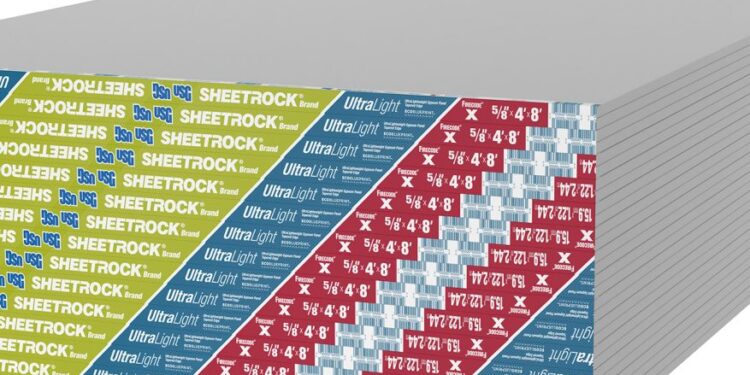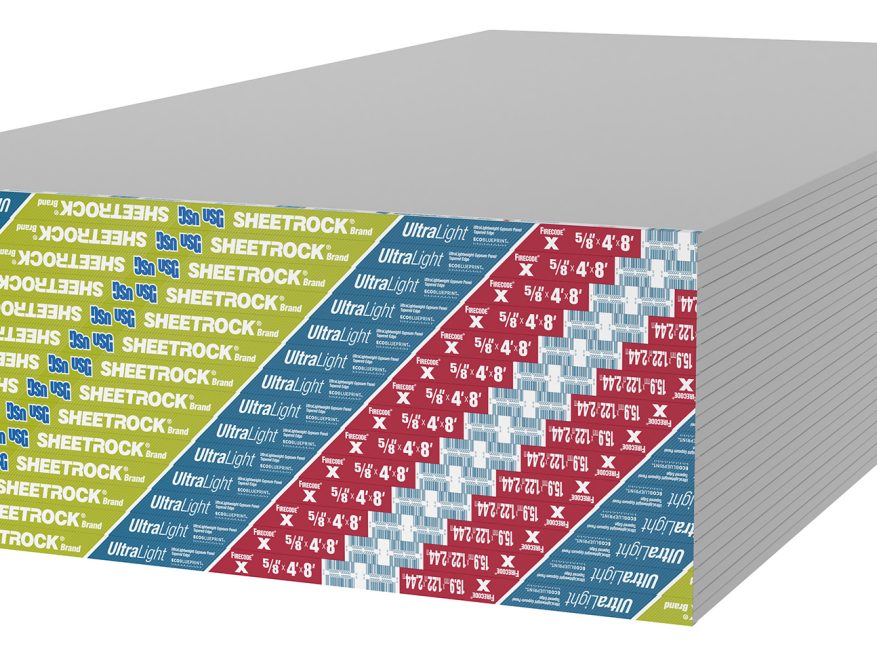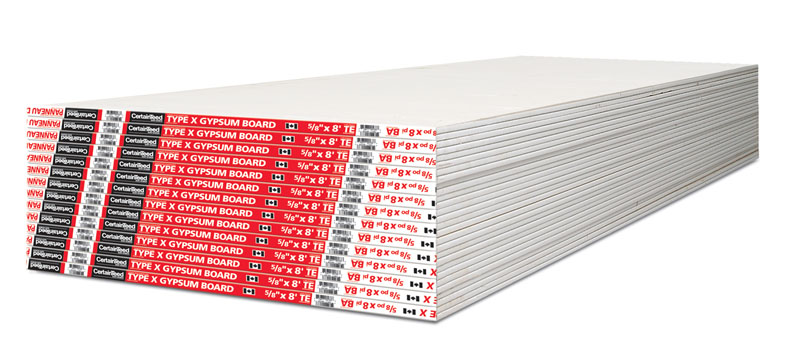Firecode for Drywall

Fire-resistant drywall gives you vital protection during home fires. Type X varieties double your safety margin from 30 minutes to a full hour compared to standard drywall. This specialized material plays a key role in modern construction as building codes evolve with safety first.
Fire-resistant drywall options have distinct differences. Type X drywall provides a one-hour fire rating in standard wood stud wall assemblies. The protection can last even longer with specialized applications. One-inch thick shaftliner panels that qualify as Type X can protect non-load bearing walls for up to 2 hours. Residential firewall requirements vary between 1 to 2 hours based on the building type. Single-family homes need 1-hour firewalls while attached housing requires 2-hour protection for shared walls.
Builders and homeowners should know the differences between standard and firecode drywall options. It’s more than just following codes—it creates safer homes. This piece covers everything about firecode drywall. You’ll learn about installation needs, costs, and how to make smart choices about this safety feature for your 2025 home.

Table of Contents
- 1 What is Firecode Drywall and Why It Matters
- 2 Where Fire-Rated Drywall is Required in 2025 Homes
- 3 Type X vs. Type C Drywall: What’s the Difference?
- 4 Cost, Availability, and Installation Tips
- 5 Beyond Drywall: Other Fire Safety Measures to Consider
- 6 Summing all up
- 7 Here are some FAQs about Firecode drywall:
What is Firecode Drywall and Why It Matters
Fire-rated drywall is a vital defense against one of our homes’ worst enemies—fire. Firecode drywall provides specialized protection that can make a real difference when emergencies happen.
What is Type X drywall?
Type X drywall represents the most common fire-rated gypsum board homeowners can buy. This specialized material has a noncombustible gypsum core wrapped in 100% recycled face and back papers that create a high-strength composite design. The core contains glass fiber reinforcement and additives engineered to resist fire longer than standard drywall.
Type X drywall measures 5/8-inch thick, making it noticeably thicker than regular 1/2-inch panels found in most homes. This extra thickness and special composition help it resist fire better. Independent testing agencies like Underwriters Laboratories (UL) must certify Type X drywall to meet fire performance standards in the ASTM C1396 Standard Specification for Gypsum Board.
Type X drywall’s benefits go beyond fire resistance. It dampens sound better and lasts longer than standard options.
Is drywall fire resistant or fireproof?
Many people misunderstand that no drywall is truly fireproof. All drywall products simply resist fire to different degrees. Standard 1/2-inch drywall resists fire for about 30 minutes before failing. Firecode Type X drywall doubles this protection to a full hour, giving you a better safety margin.
Gypsum’s unique composition makes this possible. It contains about 21% chemically combined water, which helps it work as a fire-resistive barrier. The National Fire Protection Association (NFPA) Life Safety Code rates materials from 0-500+, with lower numbers showing better fire resistance. Fire-resistant drywall scores just 15 on the flame spread rating, far below Class A fire-resistant products’ maximum threshold. Some premium products even achieve zero ratings for both flame spread and smoke development.
How fire-rated drywall slows fire spread
Fire-rated drywall’s clever design makes it work well. The gypsum core releases its chemically combined water as steam during fires, which slows heat from moving through the wall. This creates a temporary barrier that buys extra time to evacuate.
Glass fibers throughout the core keep the drywall intact under extreme heat, which delays its breakdown. Without these fibers, the drywall would crack and fall apart faster, letting flames through.
Type C drywall offers even more protection. It has extra glass fibers and vermiculite—a mineral that expands when heated—to maintain better structural integrity during fires. The expanding vermiculite fills gaps left when water evaporates from the gypsum core.
The Insurance Institute for Business & Home Safety reports that wildfires destroyed more than 35,000 structures in the past decade. Fire-rated drywall’s main purpose isn’t to stop fires completely. It creates time barriers that slow down flames and smoke as they move through buildings. This delay gives people valuable minutes to escape safely and lets firefighters arrive in time to possibly save the structure.
Where Fire-Rated Drywall is Required in 2025 Homes
Building codes nationwide require firecode drywall installation in specific areas of homes, and with good reason too. Homeowners who understand where these fire-resistant barriers belong can better protect their families and properties from devastating fire damage.
Garage walls and ceilings
The International Residential Code (IRC) states that garages must have proper fire barriers to separate them from living spaces. A minimum of 1/2-inch gypsum board must cover the garage side of any wall between an attached garage and the residence. Rooms above the garage need extra protection – the ceiling requires at least 5/8-inch Type X drywall.
Any structure that supports a floor-ceiling assembly between a garage and living space needs protection from at least 1/2-inch gypsum board. The drywall joints in garage installations must be taped or sealed, with no gaps larger than 1/20-inch.
Garages store flammable materials like gasoline, oil, and paint, which makes them high-risk areas that need special attention. Garage attic access points must have fire-rated material for their hatch covers to maintain the required 45-minute rating.
Utility and furnace rooms
Utility rooms with water heaters, furnaces, or electrical panels pose most important fire hazards in homes. Building codes typically require fire-rated drywall in these spaces to contain potential fires.
A single coat of taping works well enough in non-living areas like utility rooms and furnace closets to achieve the desired fire rating. This “fire taping” needs tape and one coat of compound on all seams and inside corners. Gaps wider than 1/16 inch around pipes, brackets, and other protrusions need tape too.
You can also use self-adhesive fire-rated tape that maintains its fire rating without joint compound. This option saves installation time while keeping safety standards intact.
Walls under stairs and between units
Staircase areas need special fire protection considerations. New fire codes require ⅝” Type X or C drywall for fire separation under stairs. Fire spreads quickly in these enclosed areas without proper protection.
Under-stairs drywall materials must resist combustion and slow down flames. Local building codes usually require these assemblies to withstand fire for one or two hours.
Multi-family dwellings must have firecode drywall between adjacent living units. Apartments, condos, and townhouses use Type X and Type C drywall on all exterior-facing and joining walls. These walls extend into the attic up to the roof line to stop fire from spreading through attic spaces.
Ceilings below living spaces
Living spaces above garages or basements need fire-rated drywall ceiling coverage to prevent flames from reaching upper floors quickly. Garages with rooms above must have 5/8-inch Type X gypsum board or equivalent material for separation.
The IRC clearly states that “garages beneath habitable rooms shall be separated from all habitable rooms above by not less than 5/8-inch (15.9 mm) Type X gypsum board or equivalent”. This barrier gives residents valuable time to evacuate safely during a fire.
Multi-family buildings often need firecode drywall for ceilings between units. This setup helps stop fires from spreading vertically between apartments or condominiums, offering vital protection in densely populated residential buildings.
Installing 5/8 firecode drywall in these required locations goes beyond just following codes – it creates a detailed fire safety system that protects both property and lives. Standard drywall might work for most interior walls, but these high-risk areas just need the superior protection that fire-resistant drywall provides.
Type X vs. Type C Drywall: What’s the Difference?
The difference between various firecode drywall types can help homeowners choose the right fire protection for their homes. Both Type X and Type C protect better than standard drywall, but they have key differences worth understanding.
Type X drywall fire rating explained
Type X drywall fire rating comes from its special mix of non-combustible materials and glass fibers throughout its core. This design helps it resist fire much longer than regular drywall. A 5/8-inch Type X panel gives you a one-hour fire rating when installed on both sides of wood or steel studs 16 inches apart. The drywall fire rating doubles to two hours with two layers on each side.
ASTM International’s strict testing standards determine Type X certification. These panels need to stay structurally sound at temperatures above 1,700°F for specific time periods.
What is Type C drywall?
Type C drywall is a better version of fire-resistant gypsum board that performs better than Type X. While they look similar, Type C includes vermiculite which expands with heat. This expansion helps offset the natural shrinkage that happens when the gypsum core releases water during fires.
Type C drywall’s core has more glass fibers than Type X. These extra fibers create stronger structural support and help the panel last longer in extreme heat.
Type C vs Type X drywall: key differences
The main differences show up under extreme heat:
- Shrinkage resistance: Type C resists shrinkage better because of vermiculite
- Glass fiber content: Type C has more glass fibers in its core
- Fire endurance: Type C lasts longer than Type X in fire tests
- Cost factor: Type C costs 15-20% more than Type X panels
- Identification: Look for “Type C” or “Type X-C” markings on Type C products
When to use Type C over Type X
You should choose Type C drywall for places that need the best fire protection:
- Stairwells and elevator shafts in multi-story buildings
- Areas that need three- or four-hour fire ratings
- Roof assemblies requiring extra fire resistance
- Buildings with hard-to-reach emergency access
- Structures housing valuable equipment or materials
Type X is good enough for basic home needs like garage walls and utility rooms. Local building codes set the minimum requirements, but Type C gives safety-conscious homeowners extra protection.
Cost, Availability, and Installation Tips
Fire-rated drywall needs careful consideration of costs and installation methods. Let’s get into what homeowners need to know about pricing, buying, and installing this important safety material.
5/8 firecode drywall vs standard drywall cost
Firecode Type X drywall costs about 10-20% more than regular drywall panels. Standard drywall prices in 2025 range from USD 12.00 to USD 20.00 per 4×8-foot sheet, while fire-resistant Type X drywall runs between USD 18.00 and USD 23.00 per sheet. The price gap becomes significant for whole-house installations—Type C drywall costs double the standard options.
Standard drywall material costs USD 0.42 to USD 0.50 per square foot, and fire-rated drywall ranges from USD 0.55 to USD 0.80. Labor costs add USD 1.45 to USD 2.80 per square foot in 2025. Total installed costs run between USD 1.80 and USD 3.50 per square foot.
Where to buy 5/8 in. x 4 ft. x 8 ft. mold tough firecode x drywall
Firecode X drywall can be found easily at major home improvement stores. Home Depot and Lowe’s stock Sheetrock Brand 5/8 in. x 4 ft. x 8 ft. Mold Tough Firecode X Drywall. Building supply stores might offer better deals for professional contractors. Fire-rated drywall is a standard product that most construction retailers carry.
Installation tips for fire-rated drywall
The fire resistance works best when you:
- Space drywall screws about 16 inches apart
- Set screws flush with the surface without breaking the paper
- Cover all seams with fire-rated joint tape
- Use fire-rated compound on joints
- Keep ⅛-inch gaps between sheets for expansion
Common mistakes to avoid
New installers often damage the surface by overscrewing, weaken seams through oversanding, and make joints too tight. Using standard joint compound instead of fire-rated products creates another serious issue. Code compliance requires proper fire-stopping material depth.
Fire-rated drywall might cost more initially, but it offers essential safety benefits and could lower your insurance costs over time.

Beyond Drywall: Other Fire Safety Measures to Consider
A complete home fire safety plan needs multiple protection layers beyond firecode drywall installation. These extra safety measures work with fire-resistant drywall to build a strong defense system against fire hazards.
Fire-rated doors and windows
Fire-rated doors stop flames and smoke from moving between rooms. This gives people valuable time to escape. These special doors can resist fire from 20 minutes to 3 hours. Hollow metal frames lead the market for fire-rated framing. Aluminum frames provide affordable options while staying non-combustible.
Heat-reflective glass windows can block up to 90% of fire heat transfer. Steel frames resist fire better than vinyl frames, which don’t perform well in fires. Regular dual-pane windows protect better than single-pane ones. The outer layer usually breaks first, and the inner pane heats up more slowly and evenly.
Smoke detectors and alarms
Smoke alarms lower the risk of death in home fires by 60%. You need alarms outside every sleeping area and on each floor, including basements and bedrooms. Connected alarms work together – when one goes off, they all sound.
Dual-sensor models are ideal because they combine two types of detection. Ionization sensors catch flaming fires better, while photoelectric sensors detect smoldering fires. Test your alarms monthly, change batteries twice a year, and replace units every 10 years.
Fire extinguishers and sprinkler systems
ABC-rated fire extinguishers handle most fire types well, including electrical, grease, and wood fires. Keep them in kitchens, garages, and near bedrooms.
Home sprinkler systems save lives. Combined with smoke alarms, they cut fire death risk by 82%. Sprinklers work successfully in 92% of fires big enough to trigger them. They keep fires contained to one room 96% of the time, compared to 72% in homes without sprinklers.
Sealing gaps and penetrations
Pipes, electrical cables, and ventilation ducts can create paths for fire spread. Sealed gaps in walls and floors slow down fires significantly.
Fire penetration sealing systems help buildings resist fire by filling gaps with special materials. These systems protect separate building sections. This gives people more time to evacuate and emergency teams more time to respond.
Summing all up
Fire safety is an investment, not an expense, when it comes to protecting your home and family. In this piece, we explored how firecode drywall acts as a vital defense against destructive forces that homeowners face. Without doubt, Type X and Type C varieties give you precious time during emergencies that could end up saving lives.
Fire-rated drywall costs 10-20% more than standard options. This premium gives you improved safety benefits by a lot. The price difference means little when compared to potential risks of poor fire protection. Smart homeowners see this cost as a basic safety investment instead of an optional upgrade.
Fire-resistant drywall works best as part of a complete safety strategy. Using it with fire-rated doors, smoke detectors, fire extinguishers, and sealed penetrations creates multiple defense layers against fire hazards. This approach improves your family’s chances to evacuate safely during emergencies.
Building codes require firecode drywall in specific high-risk areas, and with good reason too. Safety-minded homeowners might go beyond these minimum requirements, especially when you have wildfire-prone areas or older homes with outdated electrical systems. Your main goal is protecting what matters most—your loved ones and your home.
Installing fire-rated drywall shows responsible homeownership. Learning about its uses, benefits, and proper installation helps you make smart choices about this vital safety feature. As we look to safer housing standards in 2025 and beyond, firecode drywall remains essential in modern home construction and renovation—a small investment that brings peace of mind.
Here are some FAQs about Firecode drywall:
Do you need fire code drywall?
Firecode drywall is required in specific areas of construction where fire resistance is mandated by building codes. Using 5/8 firecode drywall is common for garage ceilings, furnace rooms, and shared walls between living units. The 5/8 in. x 4 ft. x 8 ft. Mold Tough Firecode X drywall provides both fire resistance and moisture protection for these critical areas.
What does firecode drywall mean?
Firecode drywall refers to specialized gypsum board products like Firecode X drywall that are designed to resist fire spread for a specified duration. Firecode type X drywall contains glass fibers and other additives that help maintain structural integrity during fires. These products, including 5/8 firecode drywall, are tested and rated for their fire-resistant properties.
How many layers of drywall for 1-hour fire rating?
A single layer of 5/8 in. Firecode X drywall typically provides a 1-hour fire rating when properly installed. Some assemblies may require two layers of 1/2-inch Firecode drywall to achieve the same rating depending on specific building requirements. The 5/8 in. x 4 ft. x 8 ft. Mold Tough Firecode X drywall is often specified for its efficient single-layer performance.
What is 45 min fire rating for drywall?
A 45-minute fire rating indicates that Firecode type X drywall can resist fire exposure for at least 45 minutes before failing. This rating is often achieved with 1/2-inch Firecode drywall in certain assemblies, while 5/8 firecode drywall typically provides longer protection. The 5/8 in. x 4 ft. x 8 ft. Mold Tough Firecode X drywall exceeds this rating in most applications.
Is drywall considered a flammable material?
Standard drywall is non-combustible, but Firecode X drywall provides enhanced fire resistance through special formulations. The 5/8 firecode drywall contains glass fibers and other additives that make it more fire-resistant than regular drywall. Products like 5/8 in. x 4 ft. x 8 ft. Mold Tough Firecode X drywall are specifically designed to slow fire spread.
Do interior walls require fire blocking?
Fire blocking is required in certain interior wall applications, particularly when using Firecode drywall in rated assemblies. The 5/8 firecode drywall installations often require fire blocking at floor and ceiling levels to maintain the fire rating. Building codes specify where fire blocking is needed, especially when using Firecode type X drywall in multi-family or commercial construction.






